Want to Tell One Wood from Another? Learn Basic Wood Anatomy
As a long-time woodworker, I have an interest in being able to tell one wood from another and in the process of learning how to do that, I’ve developed some knowledge about wood anatomy that I think will be of interest to Biology students as well as woodworkers. There is an enormous variety of wood anatomy characteristics and this article discusses just a few so as to spark interest more than to provide an extensive exposition on those characteristics. Since this article is introductory in nature and doesn’t even express all of my own limited knowledge of the subject, I’ve included at the end some references for those interested in further information. There are quite a large number of different characteristics of wood that would be of interest to a wood anatomist, but I have limited my own knowledge to the subset of those characteristics that are readily discernible to the average woodworker in his own shop/garage/basement with minimal effort and no elaborate equipment.
It usually comes as QUITE a surprise to people, even long-term woodworkers, just how much information is very readily available from the wood with a pretty small effort. I want to emphasize that all of the images in this article were taken of wood that I processed in my garage with nothing but a random orbital sander. This is not an elaborate process. THE PROCESS
The most interesting set of easily available characteristics of wood are those in the end grain of temperate zone hardwoods and that’s what this article discusses.
When you look at the end grain of hardwoods, there are two primary attributes that are of interest, the growth rings including the pore distribution within the rings, and the parenchyma. Pores are the little tubes that are used by the tree to move sap/nutrients up/down the tree and parenchyma is another wood tissue that can be arranged in quite a large number of different ways.
Table of Contents
Three steps are involved in obtaining and using anatomy wood info to identify the wood.
- EXPOSE You have to clean off the end grain sufficiently to be able to see the characteristics. Here’s a discussion of how I use a random orbital sander to clean the end grain (the process is shown at the bottom of the page) clean up end grain
- EXAMINE You have to look at the characteristics at a magnification that is easily supplied by a simple 10X jeweler’s loupe or you can (as I do) take a closeup of it with a camera that allows that. For my own photographic closeups, I use a camera that easily gives me a 12X view.
- USE You have to have a reference source or sources to help you understand what you are seeing. I have provided links to a number of those at the end of this article.
So … now on to the actual wood anatomy.
Trees in the temperate zones have growing seasons that start in the spring and continue through the summer and into the fall. This growth cycle results in annual growth rings that contain areas that are called, appropriately enough, early-wood and late-wood.
GROWTH RING COUNT
Fast-growing trees have few growth rings per inch and slow-growing trees have a lot more, so one characteristic of interest is how many growth rings does a particular piece of wood has. This can vary a great deal within many species so often is not a reliable species identification factor.

TYPES OF GROWTH RINGS
The pore distribution has several different characteristics, the most fundamental of which is the “type” of porosity (how the pores are arranged relative to the growth rings), as illustrated here:
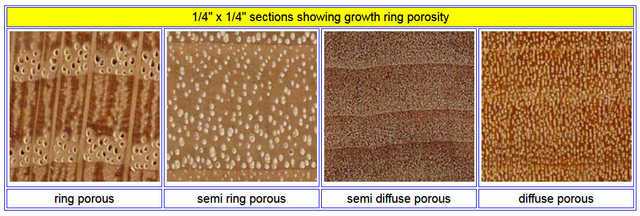
- Ring porous: large earlywood pores dropping off quickly to smaller latewood pores
- Semi ring-porous: large earlywood pores dropping off gradually to smaller and smaller pores into the latewood
- Semi diffuse-porous: almost uniform pore distribution but with some thinning out and/or smaller pores as the latewood progresses
- Diffuse porous: uniform pores throughout
RAYS
rays are batches of tissues that run from the center of the tree out to the bark. They are shown in these images running from top to bottom. There are two aspects of rays that are relevant to wood identification and they are the size of the rays and the density (how many per inch). Here, I show the various categories of thickness.
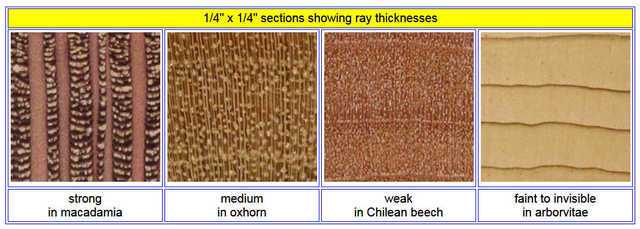
PORE DENSITY
Another characteristic of pores is how many of them there are unit of area. The general categories are shown here. “Uncountable” is a figurative term since with a good microscope you COULD count them, but for practical purposes, there’s no need.

PORE SIZE
Pores range in size from so small you can’t even see individual ones with a 10X loupe up to really large ones on woods such as red oak which are easy to see with the naked eye. In many hardwoods, the pore size will vary throughout the grown ring, as you can see in the sparse pore image directly above. Deciding what size to call a pore can be a bit subjective but here is the range
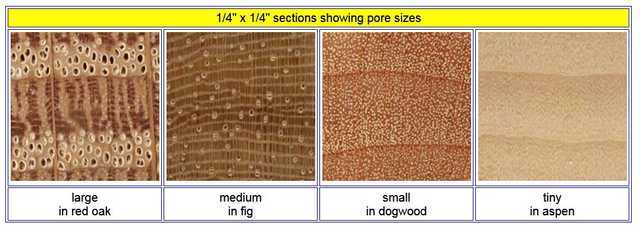
PORE Multiples
Often pores will grow adjacent to each other and share a cell wall. When that happens, it’s referred to as a pore “multiple”. Multiples can occur as groups all the way up to 8 or 9 but that’s rare. Groups of 2 and 3 pores are quite common. The orientation of the pore groups is also significant. Sometimes they are radial and sometimes tangential and they can even be random. Here are some examples. The orientation of all of these images is that the center of the tree is at the bottom and the outside of the tree is at the top, so bottom-to-top is radial and left to right is tangential.

DENDRITIC GROUPS
“Dendritic” means “tree-like” and this particular arrangement of pores appears, rather loosely, to be in the shape of tree branches. There are not, as far as I am aware, any formal designations for the different types with the dendritic group but I use the rather obvious designation shown here:
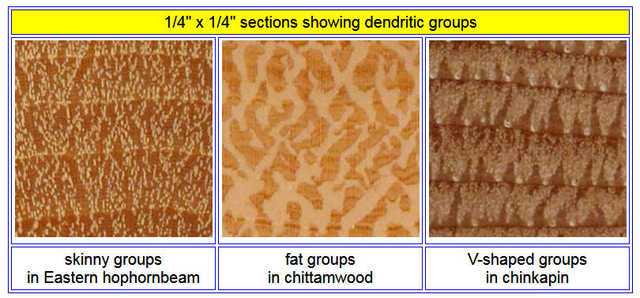
WAVY BANDS
Pores group together in a wide variety of ways. The dendritic groups directly above are one such and another is wavy bands, which is just what it sounds like:
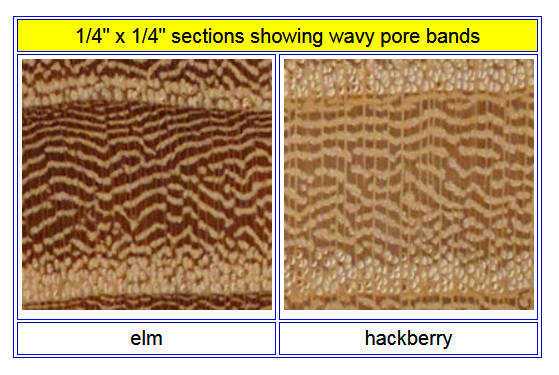
AILIFORM PARENCHYMA
“Aliform” means “wing-shaped” or “winglike” and there are two groupings of parenchyma cells that fall in this category. Since aliform means wing-shaped, it’s a bit weird but the first type is called wing-shaped aliform parenchyma, which is a bit like calling it wing-shaped wing shaped, but this is because (1) this form LOOKS solidly wing-shaped and (2) there is another form, lozenge-shaped, that it needs to be distinguished from. I really find the wing-shaped aliform parenchyma funny because if you get a really good example, like the one shown here, it’s easy to see it as a squadron of WWII fighter jets bearing down on you. The lozenge-shaped form looks a bit like a cough lozenge. The parenchyma cells surround the pores and move off to either side in one of the two forms shown here.
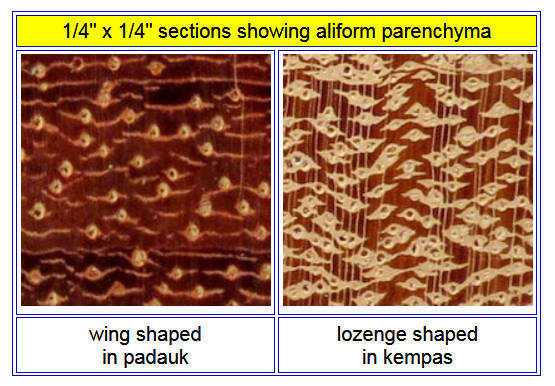
A FEW OTHER PARENCHYMA TYPES
The images below show a few of the other parenchyma types, shown here as horizontal lines in the images.
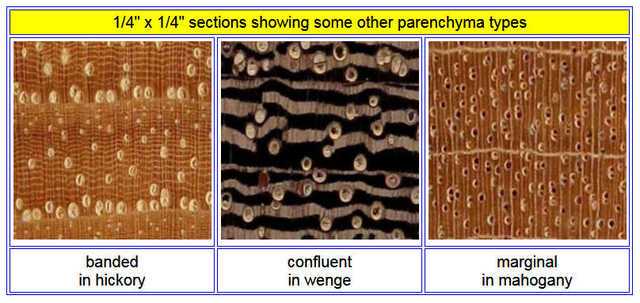
What I’ve gone over above here is just a sample of the characteristics, just to show some of them.
And now for the fun part. Here’s a small sample of how the characteristics described above look in various combinations for a few kinds of wood. These are all 1/4″ x 1/4″ end grain cross-sections. Once you have some familiarity with the various characteristics, using them to identify woods can be (but isn’t always) fairly easy. Just look at the variety in this batch:
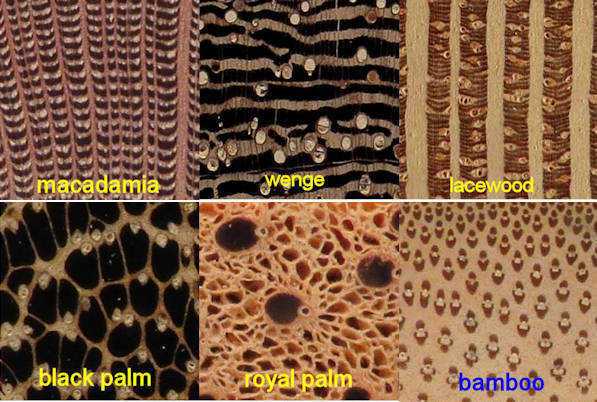
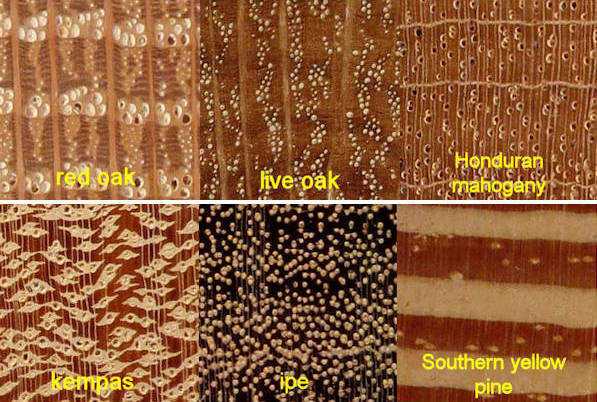
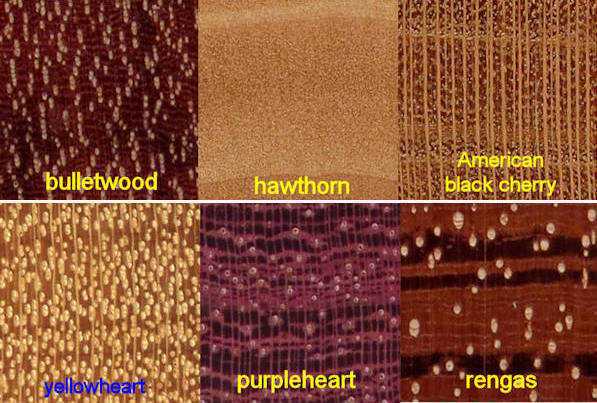
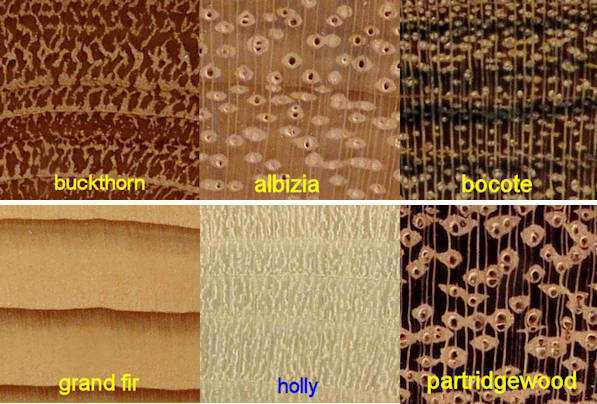
REFERENCES
Understanding Wood by Bruce Hoadley
Identifying Wood by Bruce Hoadley
wood anatomy — an introduction
extensive parenchyma discussion
extensive growth ring discussion
massive compilation of wood images and discussion, broken out by 400+ species
50,000+ images of wood anatomy — this one takes a bit of a learning curve and requires botanical names (e.g. Quercus rubra) rather than the common names (e.g. red oak) but it is the most extensive resource I’m aware of for wood anatomy. Note that the number of images linked to on the main page is over 230,000 but most of these are not wood anatomy.
Studied EE and Comp Sci a LONG time ago, now interested in cosmology and QM to keep the old gray matter in motion.
Woodworking is my main hobby.

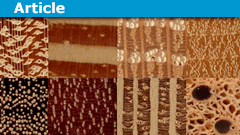








My understanding is that "shop" doesn't exist any longer. Kids could hurt themselves on the power tools, or even the hand tools for that matter. Every woodworking show I've been to in the last 10 years has been a sea of white hair. Young folks are into electronic stuff (USING it of course, not experimenting with it).
By the way, "afromosia" is the way I spell it for a long time too, but it's actually "afrormosia".
Do you mean designating bamboo as a wood for commercial purposes. It's just words. It's like the preposterous names that are made up in the flooring industry for woods that have perfectly good names but which (names) are not euphonious enough for sales people. For example, "Patagonian rosewood" instead of goncalo alves.
Actually, that's a good point. In my more extensive expositions I spend more time discussing the pros and cons of some reference sources since they are, as you point out here, at the heart of the whole thing. I just take it for granted that the point of the data identification and collection is ultimately to ID the wood so kind of slid past the fact that I was making an assumption here that may not have been obvious (Although the title of the Insight is a big clue )
)
Sorry, I did not get the point. I missed this sentence midway through the text. "You have to have a reference source or sources to help you understand what you are seeing. I have provided links to a number of those at the end of this article."
So the real subject of the article is not about the identification step, but rather the anatomy data gathering steps.
By the way, in case you are not aware of it "maple syrup" when it comes out of the tree is essentially indistinguishable from water (it's about 97 to 98% water and only about 2% sugar).
Glad you enjoyed it. There is MUCH more to it that the little bit that's in the article.
Uh … did you not get the POINT of the article? Identifying wood is what the whole thing is about. People send me wood from all over the country for me to try to ID it, and I run a wood identification sub-forum on the Wood Barter forum. When I buy wood, I rarely trust the seller's ID unless it's a very common domestic. Many exotics I can now identify with a quick glance but a lot of them require verification (or re-identification) using the techniques discussed in this article.
I have no idea about the carbon. Never thought about it.
No idea. I just know that even for amazingly tall trees, the sap moves all the way to the top.
No, surprisingly enough the pores of sugar maple are not significantly different than the pores of other maples. Here's a sugar maple (acer saccharum) end grain on the left and a silver maple (acer saccharinum) on the right.
View attachment 254518
Heartwood is dead wood so it doesn't change characteristics particularly with age. Some woods are almost all sapwood so, no, sapwood in general is not a bad thing. Depends on the wood.
I assume you mean "trunk" not "truck". Branches can start well after a tree has grown a bit so are not useful for telling the age of the tree, just the branch itself and there's not much point in that. Some small trees/bushes produce very small pieces that are favored by pen makers, so size relevance has to be measured against what you want to do with the wood.
Excellent.
Branches should have growth rings as well.
I suppose one could count the truck rings and compare to the branch rings and find out the ages of each.
The higher up one goes along the truck, or main branch, the number of rings should diminish.
Is there any size or age of truck/branch that it needs to be for "good" wood to work with.
Does the heartwood age in quality as the tree itself ages, the deeper in one goes the better it gets.
Sapwood, I suppose is not too well favoured for woodworking.
You label the pictures with the species of tree. How did you know those names? By sight? Did you order a piece by species name?
The mass of a tree is mostly carbon, fixed from the atmosphere. The tree top needs mass. The roots need mass. Do those pores just move water and nutrients or do they move masses of carbon also? If carbon is produced in the leaves, then it must flow inward then downward, correct?
Trees also need a lot of water. How many liters per day are lifted from the roots to above ground? Is there a kg/sec flow rate for water in the biggest trees?
The pores of sugar maples are critical to syrup production. Are they extra big? Are they clustered near the outer bark so that they freeze/thaw every day in spring?
curlyfigure
I have read one of your references, the "Understanding Wood" book and was really impressed with it.
I like wood with unusual grain (seen longitudinally), like curly maple and related effects with other names.
I realize that is viewing the wood from another axis and think it is due to waviness in the way the longitudinal components are laid down, but don't fully understand it.
Any insights on that? (Maybe another Insight)